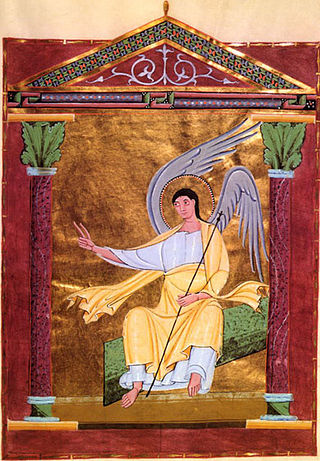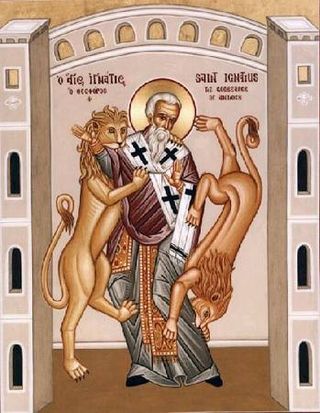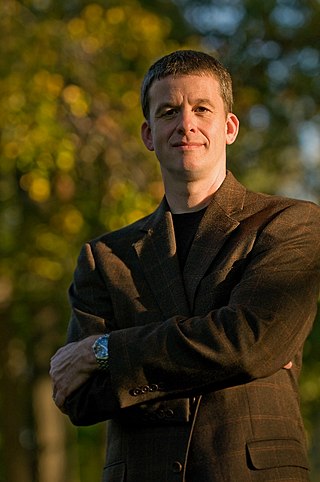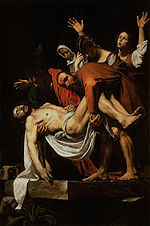
In Christianity, Christology, translated from Greek as 'the study of Christ', is a branch of theology that concerns Jesus. Different denominations have different opinions on questions such as whether Jesus was human, divine, or both, and as a messiah what his role would be in the freeing of the Jewish people from foreign rulers or in the prophesied Kingdom of God, and in the salvation from what would otherwise be the consequences of sin.

Mary Magdalene was a woman who, according to the four canonical gospels, traveled with Jesus as one of his followers and was a witness to his crucifixion and resurrection. She is mentioned by name twelve times in the canonical gospels, more than most of the apostles and more than any other woman in the gospels, other than Jesus's family. Mary's epithet Magdalene may be a toponymic surname, meaning that she came from the town of Magdala, a fishing town on the western shore of the Sea of Galilee in Roman Judea.

The resurrection of Jesus is the Christian belief that God raised Jesus from the dead on the third day after his crucifixion, starting – or restoring – his exalted life as Christ and Lord. According to the New Testament writing, Jesus was firstborn from the dead, ushering in the Kingdom of God. He appeared to his disciples, calling the apostles to the Great Commission of forgiving sin and baptizing repenters, and ascended to Heaven.
The Christological argument for the existence of God, which exists in several forms, holds that if certain claims about Jesus are valid, one should accept that God exists. There are three main threads; the argument from the wisdom of Jesus, the argument from the claims of Jesus as son of God and the argument from the resurrection.

The empty tomb is the Christian tradition that the tomb of Jesus was found empty after his crucifixion. The canonical gospels are consistent on the incident, with variations, of the visit of women to Jesus' tomb. Although Jesus' body had been laid out in the tomb after crucifixion and death, the tomb is found to be empty, the body gone, and the women are told by angels that he has risen. The gospel accounts are based on earlier oral traditions.
The historicity of Jesus is the question of whether or not Jesus of Nazareth historically existed. The question of historicity was generally settled in scholarship in the early 20th century, and today scholars agree that a Jewish man called Jesus of Nazareth did exist in the Herodian Kingdom of Judea and the subsequent Herodian tetrarchy in the 1st century CE, upon whose life and teachings Christianity was later constructed.
The term "historical Jesus" refers to the life and teachings of Jesus as interpreted through critical historical methods, in contrast to what are traditionally religious interpretations. It also considers the historical and cultural contexts in which Jesus lived. Virtually all scholars of antiquity accept that Jesus was a historical figure, and the idea that Jesus was a mythical figure has been consistently rejected by the scholarly consensus as a fringe theory. Scholars differ about the beliefs and teachings of Jesus as well as the accuracy of the biblical accounts, with only two events being supported by nearly universal scholarly consensus: Jesus was baptized and Jesus was crucified.

Jewish Christians were the followers of a Jewish religious sect that emerged in Judea during the late Second Temple period. These Jews believed Jesus to be the prophesied Messiah, but maintained the observance of Jewish law. Jewish Christianity is the foundation of Early Christianity, which later developed into Catholic and Eastern Orthodox Christianity. Christianity started with Jewish eschatological expectations, and it developed into the worship of Jesus as the result of his earthly ministry, his crucifixion, and the post-crucifixion experiences of his followers. Modern scholarship is engaged in an ongoing debate as to the proper designation for Jesus' first followers. Many see the term Jewish Christians as anachronistic given that there is no consensus on the date of the birth of Christianity. Some modern scholars have suggested the designations "Jewish believers in Jesus" or "Jewish followers of Jesus" as better reflecting the original context.

Most scholars who study the historical Jesus and early Christianity believe that the canonical gospels and the life of Jesus must be viewed within their historical and cultural context, rather than purely in terms of Christian orthodoxy. They look at Second Temple Judaism, the tensions, trends, and changes in the region under the influence of Hellenism and the Roman occupation, and the Jewish factions of the time, seeing Jesus as a Jew in this environment; and the written New Testament as arising from a period of oral gospel traditions after his death.

Jesus, also referred to as Jesus Christ, Jesus of Nazareth, and many other names and titles, was a first-century Jewish preacher and religious leader. He is the central figure of Christianity, the world's largest religion. Most Christians believe Jesus to be the incarnation of God the Son and the awaited messiah, the Christ that is prophesied in the Old Testament.

The Christ myth theory, also known as the Jesus myth theory, Jesus mythicism, or the Jesus ahistoricity theory, is the view that the story of Jesus is a work of mythology with no historical substance. Alternatively, in terms given by Bart Ehrman paraphrasing Earl Doherty, it is the view that "the historical Jesus did not exist. Or if he did, he had virtually nothing to do with the founding of Christianity."

Géza Vermes, was a British academic, Biblical scholar, and Judaist of Jewish–Hungarian descent—one who also served as a Roman Catholic priest in his youth—and scholar specialized in the field of the history of religion, particularly ancient Judaism and early Christianity. He is best known for his complete translation of the Dead Sea Scrolls into English; his research focused on the Dead Sea Scrolls and other Ancient Hebrew writings in Aramaic such as the Targumim, and on the life and religion of Jesus. Vermes was one of the most important voices in contemporary Jesus research, and he has been described as the greatest Jesus scholar of his time. Vermes' written work on Jesus focuses principally on the Jewishness of the historical Jesus, as seen in the broader context of the narrative scope of Jewish history and theology, while questioning and challenging the basis of the Christian doctrine on Jesus.

The stolen body hypothesis posits that the body of Jesus Christ was stolen from his burial place. His tomb was found empty not because he was resurrected, but because the body had been hidden somewhere else by the apostles or unknown persons. Both the stolen body hypothesis and the debate over it presume the basic historicity of the gospel accounts of the tomb discovery. The stolen body hypothesis finds the idea that the body was not in the tomb plausible – such a claim could be checked if early Christians made it – but considers it more likely that early Christians had been misled into believing the resurrection by the theft of Jesus's body.

Bart Denton Ehrman is an American New Testament scholar focusing on textual criticism of the New Testament, the historical Jesus, and the origins and development of early Christianity. He has written and edited 30 books, including three college textbooks. He has also authored six New York Times bestsellers. He is the James A. Gray Distinguished Professor of Religious Studies at the University of North Carolina at Chapel Hill.

The term proto-orthodox Christianity or proto-orthodoxy describes the early Christian movement that was the precursor of Christian orthodoxy. It was coined by Bentley Layton, but is often erroneously attributed to New Testament scholar Bart D. Ehrman. Ehrman argues that this group from the moment it became prominent by the end of the third century, "stifled its opposition, it claimed that its views had always been the majority position and that its rivals were, and always had been, 'heretics', who willfully 'chose' to reject the 'true belief'." In contrast, Larry W. Hurtado argues that proto-orthodox Christianity is rooted in first-century Christianity.

Michael R. "Mike" Licona is an American New Testament scholar, author, and Christian apologist. He is Professor of New Testament Studies at Houston Christian University, Extraordinary Associate Professor of Theology at North-West University and the director of Risen Jesus, Inc. Licona specializes in the resurrection of Jesus, and in the literary analysis of the Gospels as Greco-Roman biographies.

The burial of Jesus refers to the entombment of the body of Jesus after crucifixion, before the eve of the sabbath described in the New Testament. According to the canonical gospel narratives, he was placed in a tomb by a councillor of the Sanhedrin named Joseph of Arimathea; according to Acts 13:28–29, he was laid in a tomb by "the council as a whole". In art, it is often called the Entombment of Christ.

Christianity in the 1st century covers the formative history of Christianity from the start of the ministry of Jesus to the death of the last of the Twelve Apostles and is thus also known as the Apostolic Age. Early Christianity developed out of the eschatological ministry of Jesus. Subsequent to Jesus' death, his earliest followers formed an apocalyptic messianic Jewish sect during the late Second Temple period of the 1st century. Initially believing that Jesus' resurrection was the start of the end time, their beliefs soon changed in the expected Second Coming of Jesus and the start of God's Kingdom at a later point in time.
The historical reliability of the Gospels is evaluated by experts who have not found a complete consensus. While all four canonical gospels contain some sayings and events which may meet one or more of the five criteria for historical reliability used in biblical studies, the assessment and evaluation of these elements is a matter of ongoing debate.
Scholars have given various interpretations of the elements of the Gospel stories.













